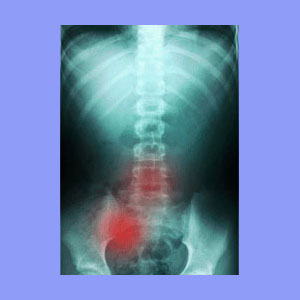
Sciatica x-rays are often the first professional diagnostic testing any patient might have performed, especially after injuring their back. X-rays are a wonderful diagnostic tool, but are virtually useless in discovering the actual causes of sciatica and most other back pain syndromes.
This article focuses on the great limitations of using x-ray technology to diagnose sciatica. We will detail the flaws of diagnostic evaluation solely using x-rays, as well as provide the few examples of conditions which may be accurately identified using x-rays.
Diagnosis via Sciatica X-Rays
Many doctors and chiropractors take x-rays as part of a typical examination of a new patient. X-rays will clearly show the vertebral structures and will also show if any spinal discs have lost height. Normal x-rays can never accurately diagnose soft tissue conditions, such as degenerative disc disease or a herniated disc. Although the space normally occupied by the disc will show up as empty on an x-ray, it is virtually impossible to differentiate between the various conditions which might create a loss of disc mass or height.
Do not allow your doctor to diagnose you with a herniated disc or even DDD without insisting on an MRI or CT scan. Of course, since sciatica is a neurological syndrome, it would be good to use a technology which better details the spinal anatomy, and especially covers the regions suspected to be involved in the symptomatic process. For this, MRI wins every time.
Usefulness of X-Ray Imaging
X-rays will show if there are any abnormal bone spurs which might be in close proximately to a spinal nerve root. Although most of these osteophyte growths are harmless and do not cause any pain, at least the x-ray film will give the doctor reason to pursue additional testing to determine if the bone spur is indeed compressing a nerve.
Osteophytes are targeted for causing many pinched nerve conditions, although most of the time, these products of spinal aging are typically coincidental and innocent of all blame. Remember, in order for an osteophyte to actually compress a spinal nerve root, the spur must almost completely close the normal foraminal opening between vertebrae or significantly reduce the patency of the central canal.
X-rays are also useful for identifying spondylolisthesis and abnormal spinal curvatures, including scoliosis, hyperlordosis and hypolordosis, which may all create sciatica in extreme cases.
To summarize, x-rays are great for taking preliminary pictures of the skeleton, but that is where their usefulness abruptly ends.
Advice on Undergoing Sciatica X-Rays
X-rays are a good starting point when trying to diagnose a chronic back pain concern. Usually, x-rays will be more useful to tell a doctor what is not causing the pain, rather than clarifying what is indeed creating the symptoms.
For example, my early x-rays showed an obvious narrowing of the intervertebral spaces at L4/L5 and L5/S1. Being that my chiropractor was not very thorough, he suspected degenerative disc disease and that was the diagnosis he made.
A bit down the line, I was diagnosed with 2 herniated discs in the exact same location. My new doctor speculated that this was a new condition, but other doctors later told me that they think these discs were herniated for a long time. Now, if the original chiropractor ordered an MRI instead of just x-rays, there would be no doubt whether DDD was the actual situation or whether those smaller intervertebral spaces already existed due to herniated discs. Being that the more advanced and detailed diagnostic test was never done, I will never know the truth.
At some point in my sciatica story, this fact bothered me so much. I really thought that maybe if those herniations were treated differently a little sooner, then maybe, just maybe, I could have been cured. Well, that is old news now. Finding out about my first chiropractor’s less than precise diagnostic method pales in comparison to the fact that all my doctors had the condition misdiagnosed anyway.
In conclusion, I am not anti-x-ray. However, I have a real problem when doctors, and especially chiropractors, take them simply to frighten patients with images of spinal abnormalities which are most likely circumstantial to the symptomatic expression. I take even more exception when x-rays show a potentially dire spinal issue, yet more comprehensive imaging is never ordered or completed.





